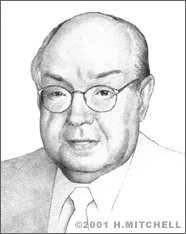Paul Baran
Paul Baran, computer technologist and entrepreneur, was responsible for one of the fundamental concepts that enable today’s advanced computer networking systems: digital packet-switching. As such, he has sometimes been referred to as one of the “grandfathers of the Internet.”
Baran was born in Poland on April 29, 1926. In 1928, his family moved to the United States, and Baran spent much of his childhood helping out with the family grocery store in Philadelphia. After high school, he attended Drexel University, where he earned a degree in electrical engineering. When he left Drexel, Baran took a job as a technician at the Eckert-Mauchly Computer Corp. where he worked on Univac, the world’s first computer. Soon after, he married and moved to Los Angeles to work at the Hughes Aircraft Company. He began taking night classes at the University of California at Los Angeles and earned a master's degree in engineering in 1959.
That year, Baran left Hughes to work for the computer science department in the mathematics division of RAND Corporation, a nonprofit research and development organization. At that time, Rand focused on Cold War-related military problems, and Baran became interested in the survival of communication networks in the event of a nuclear attack. It was then that he conceived of the Internet and digital packet switching, which allows pieces of information to be divided into small packets of data that are addressed, sent to a specific destination, and then reassembled.
Baran had been working off of the idea that the U.S. had to be able to survive a first strike from the Soviet Union and still be able to launch a counter-attack. Baran thought he could design a more powerful communication network by using digital computers and by introducing redundancy. Although he faced skepticism, Baran persevered. He studied the brain and found that it can recover lost functions by bypassing a dysfunctional region; it does so by not solely relying on a single set of dedicated cells for a given function. He thought he might be able to apply this principle to the design of a communication network.
Thus, Baran suggested a distributed network—"a communication network which will allow several hundred major communications stations to talk with one another after an enemy attack." This type of system would have no centralized switch. He also had the idea to divide messages into "message blocks" before sending them out across the network. Each block would be sent separately and rejoined into a whole when they were received at their destination. This concept later came to be known as packet switching.
Years later, Lawrence Roberts was beginning work on the ARPANET at the Massachusetts Institute of Technology when he heard of Baran's ideas. He was designing a network both to facilitate communications between ARPA researchers and to allow them to use remote computing resources effectively. He decided to adopt Baran's distributed network and packet-switching schemes, and Baran became an informal consultant for the ARPANET project, which eventually led to what we now call the Internet.
Baran served as board chairman and founder for Com21 Inc., an early pioneer in developing cable modem-based high-speed high-bandwidth for Internet access, until his death in 2011. He founded six companies in Silicon Valley including Cable Data Associates, established in Menlo Park in 1974. Telebit, his second company, was acquired by Cisco Systems. Equatorial Communications was acquired by Comtel and then acquired GTE. Packet Technologies became StrataCom and again was subsequently acquired by Cisco Systems. Baran also co-founded Metricom International with Paul Allen. He was co-founder of the Institute for the Future, a Life Fellow of the Institute of Electrical and Electronics Engineers and a Fellow of the American Association for the Advancement of Science.


